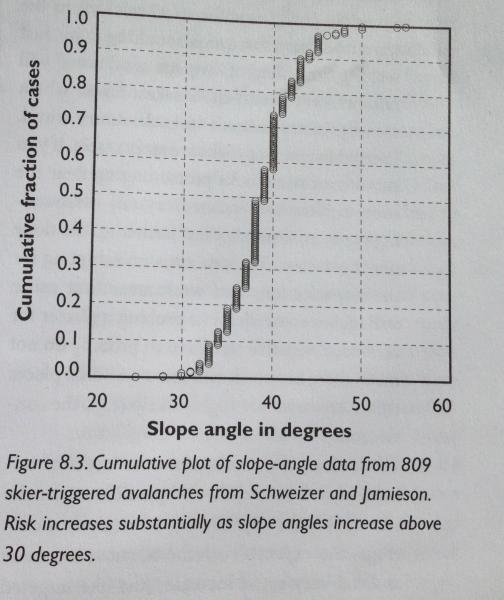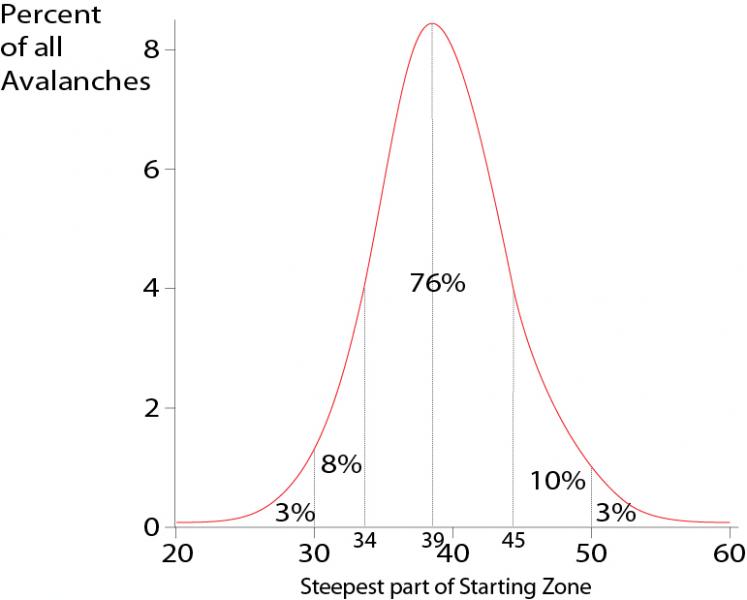
Recent avalanche accidents in Utah highlight slope steepness as a primary contributing terrain factor and illustrate what seems an obvious truth, that the steeper the slope, the greater the danger. But, not only are more and more people venturing into the backcountry these days in search of untracked powder, but people are apparently also venturing onto steeper and steeper slopes for various reasons. Slope steepness might be considered more of a "human factor" issue in many avalanche accidents than that of mistakes made in "terrain assessment."
Jill Fredston and Doug Fesler discuss the importance of slope steepness in their best selling classic, Snow Sense, "The underlying concept is that as the slope angle increases, so does the stress exerted on the snowpack." Avalanche experts agree that most avalanches occur on slopes with angles ranging between 30 and 45 degrees, but there is some discord regarding dangerous slab avalanche frequency as slope angles steepen. In The Avalanche Handbook, (3rd edition), McClung and Schaerer state that "Risk increases with slope angle. Frequency of skier triggering increases strongly with slope angle."

"Frequency of skier triggering increases strongly with slope angle."
McClung and Schaerer add that not only does the frequency of avalanches increase with slope angle, but avalanches on steeper slopes are more dangerous as well, "Not only does the chance of triggering increase dramatically with slope angle, so does the consequence: on steeper slopes the downslope gravitational driving force is higher and slabs pick up speed rapidly. For the same slab size, a 50 degree slope is more dangerous than a 30 degree slope: the downslope gravitational force increases by more than 50%."
In his book, Staying Alive in Avalanche Terrain, my esteemed cohort and awsome supervisor, Bruce Tremper agrees to a certain extent, "Danger increases with increasing slope steepness and bull's-eyes around 38 to 40 degrees, on steeper slopes, avalanche danger counterintuitively starts to decrease." In apparent contradiction of McClung and Shaerer, Tremper argues, "Especially as the slope climbs above 50 degrees, sluffs and smaller slabs run more frequently and significantly reduce the number of deeper, more dangerous slabs. This does not mean large slab avalanches don't occur on 60-degree slopes, because they certainly do. It just means that they are less common than on 40-degree slopes."
Fredston and Fesler support the concept of an increasing danger with slope angle, but suggest a decrease in slab avalanche frequency at an even steeper slope angle, "Above roughly 60 degrees, the snow tends to continually sluff off and not accumulate. Notable exceptions do occur, however, particularly in wet, maritime, or wind-affected snowpacks where very deep slab releases (>30 feet/10 meters) triggered by large cornice breaks have been observed on slopes steeper than 60-65 degrees."
If you combine the words of the experts, you could conclude that avalanche danger significantly increases with slope angle as you rise above 30-degrees, but beyond 50-degrees (Tremper) or 60-degrees, (Fredston and Fesler,) the likelihood of dangerous slab avalanches decreases.

This is the latest graph from the Swiss, which shows a smooth curve. This steepness data comes from measured slope angles from the steepest part of the bed surface that is 10 x 10 meters in size. In maritime climates, the steepness is a little greater. Bruce tells me that this data shows slab avalanche frequency declines above 39-degree slope angles.
Even though the frequency of slab avalanches declines on steeper slopes, I doubt that many people ski down or ride up 50+ degree slopes because they think they are safer, and the discussion of a decreasing danger beyond a certain slope angle is really only of concern to climbers and alpinists or "extreme skiers", who might choose routes on steeper faces as opposed to lower angled "prime angle (30-45 degree) slopes or commonly avalanche swept gullies. Falls are of equal or greater concern in such terrain, and Tremper says of slopes steeper than 55 degrees, "Wow, it's a cliff. Give me a rope." I'd argue that since terrain steeper than 50-degrees is in most cases bounded by less steep terrain, (30 to 49-degree slopes), it might be better when explaining the problem to backcountryskiers and riders just to simply say that avalanche danger increases with slope angle.
Of course, it depends on the type of avalanche problem you might encounter, but I think forecasters agree that as the avalanche danger level increases, human triggered avalanches become more frequent on lower angled slopes. So, as the snow stabilizes, the avalanche danger level decreases, triggered avalanches become less likely on lower angled slopes and yet may remain more possible on steeper slopes (up to a certain slope angle.) If there is a Moderate danger of persistent slab avalanches, for example, it would be more dangerous to venture onto a 40 degree slope than onto a 37 degree slope, since avalanches on the steeper slope are more likely (or frequent). It would also be more dangerous on a 50 degree slope, since even if avalanches may be less frequent they have greater consequence, and you usually have to cross lower angled slopes in the "bull's eye" slope angle range in order to access to or egress from very steep slopes...
Regardless of this discussion, the question remains: Why are more and more people attracted to steeper and steeper terrain?
In Deep Powder Snow, Dolores LaChapelle writes, "When skiing deep powder, the steeper the slope, the more easy it is for the snow and gravity to turn you, so the greater the bliss. That's why we ski such steep slopes." In other words, the quality and depth of the snow determine the amount of risk one is willing to take to find the 'bliss" in the perfect balance of slope angle and powder. Deep powder skiers often understand the danger of plunging into steep terrain, but we are willing to take the risk because of the great and indescribable reward.
It's a bit harder for me to understandthe motivation driving the increasing popularity of venturing into steep terrainwhen snow conditions aren't so good. LaChapelle doesn't relate so well with ski mountaineering or the growing popularity extreme skiing or riding "This type of skiing is for those who are addicted to adrenaline or for a macho person trying to prove how good he is. Such skiing is usually windblown snow or crust; not powder. The steeper and more rugged the terrain, the more they can prove how good they are---totally anthropocentric."
Certainly, there's a powerful draw to rocket up a 45+ degree slope on a sled or put your personalized tracks down an eye-catching mountain chute, but for me, it's not worth the risk in steep terrain if the snow is not very good. I sometimes find myself wondering about the value of my sketchy experiences on steep slopes in less than ideal snow. It would certainly be a bummer to get caught in an avalanche while jump-turning through crud, crashing through breakable crust, or wondering when I might break through an inconsistent wind board.. Here's where the human factor comes into the discussion. Are we on this very steep slope for a good and memorable experience, to feel LaChapelle's bliss, or are we just sticking to our goal-oriented plan, showing off, and overly brimming with testosterone?
Please send comments or further discussion of slope steepness to [email protected] and I'll share your thoughts here.....
Wow Toby. I was totally with you in the first 90% of your blog- educating the public, discussing the difference of frequency vs consequence for slides in steep terrain. All pretty basic stuff, but a good educational message nonetheless. And then you quietly slid from professional public educator into personal rant. Just because you (and LaChapelle) think "its not worth the risk in steep terrain if the snow is not very good" did you really have to use this venue to admonish people for "showing off", being too goal oriented, and "overly brimming with testosterone" just because they choose to ski steep terrain in conditions that you think are not very good? This is absurd. Of course anybody would rather ski blower pow than crud. But the truth of it is it's much more a problem that people get powder fever and accept higher avalanche risks because they think the skiing will be incredible than those who conservatively ski radical lines in marginal snow with good stability. Would it really be any more of a bummer to get caught in an avalanche while jump turning through crud than when blissfully plunging into steep terrain knowing that you took a higher risk because you couldn't resist the great and indescribable reward? Absurd. It might be more appropriate for you to reexamine your own human factor. Everybody has their own reasons, everybody has their own bliss. This is not the right avenue for your judgments.
Yep...... my own human factors, and that section is written in the first person for the most part. I'm not really judging anyone but myself. I'm the one wondering what the XXXX I'm doing up on a steep slope in marginal conditions, which seems to happen far too often...
Hey Toby, Thank you for informative and entertaining post......The relationship between slope angle and skier triggering caught my attention. Based on the extensive work done by Hierli, Ron S, Karl and Ned Bair, it appears that the type of weak layer, persistent, storm snow or non persistent, influences the slope angle. I had a conversation with Ned Bair yesterday and he believes the slope angle is ~32-34 degrees for persistent weak layers. -
It would be interesting to hear what others think about this.






